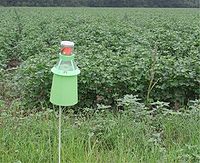
Photo from wikipedia
Rice is a staple food in Senegal, which however imports more than 70% of the rice consumed annually to meet its domestic demand. Despite governmental efforts to increase rice self-sufficiency,… Click to show full abstract
Rice is a staple food in Senegal, which however imports more than 70% of the rice consumed annually to meet its domestic demand. Despite governmental efforts to increase rice self-sufficiency, both rice supply and yields remain low. Senegalese farmers face challenges related to irrigation infrastructure and fertiliser access, besides those derived from climate change. This study applies Life Cycle Assessment (LCA) combined with financial Life Cycle Costing (LCC) to evaluate alternative scenarios for rice management in the Senegal River Valley and identify sustainability hotspots and potential improvements. Specifically, rice cultivation in Ross Béthio (Saint Louis, Senegal) is assessed based on the observed agricultural practices during the dry seasons of 2016 and 2017. Two scenarios capturing conventional (CONV) and intensive (INT) practices are compared to two reference scenarios (SAED scenarios) according to the recommendations of the official agricultural advisory service. The INT scenario generates the lowest impacts per kg of paddy rice in seven out of thirteen impact categories, including climate change, freshwater and marine eutrophication, ozone depletion and water scarcity. This is due to the higher yields (7.4 t ha-1) relative to CONV (4.8 t ha-1) and the two reference SAED scenarios (6.0 t ha-1). The two latter scenarios show the lowest values in the remaining categories, although they also generate slightly lower profits than INT (138 € t-1 vs. 149 € t-1) due to increased labour costs for additional fertilisation treatments. The results from both LCA and LCC underline the importance of increasing yields to decrease environmental impacts and production costs of rice when estimated per kg of product. Well-designed fertiliser application doses and timing and increased mechanisation can deliver further environmental benefits. Additional improvements (e.g. in irrigation, crop rotations, straw management) could be considered to promote the long-term sustainability and profitability of rice production in Senegal. LCA in combination with financial LCC is identified as a decision-support tool for evaluating the sustainability of alternative crop management practices. Life Cycle Thinking can still benefit from experiential learning based on information exchange between farmers, researchers and extension agents to contribute to a sustainable agriculture and ultimately to food security in Africa.
Journal Title: Journal of environmental management
Year Published: 2022
Link to full text (if available)
Share on Social Media: Sign Up to like & get
recommendations!